Managing a Successful Business Project: Waitrose CSR Impact Report
VerifiedAdded on 2020/01/28
|17
|3522
|83
Report
AI Summary
This report presents a comprehensive analysis of a project evaluating the impact of Waitrose's Corporate Social Responsibility (CSR) initiatives. The project employed a detailed project management plan, including work breakdown structures, Gantt charts, and a budget, to assess CSR's influence on stakeholders. Primary data was collected through questionnaires, while secondary data provided context on Waitrose's CSR practices. The findings reveal stakeholders' awareness and dependence on CSR policies. The report includes quantitative and qualitative data analysis, presenting key findings on stakeholder preferences and satisfaction. Recommendations are provided to enhance current CSR practices, supported by a reflection on project planning and outcomes. The project underscores the significance of CSR in fostering stakeholder engagement and sustainable business practices within the Waitrose and John Lewis Partnership.
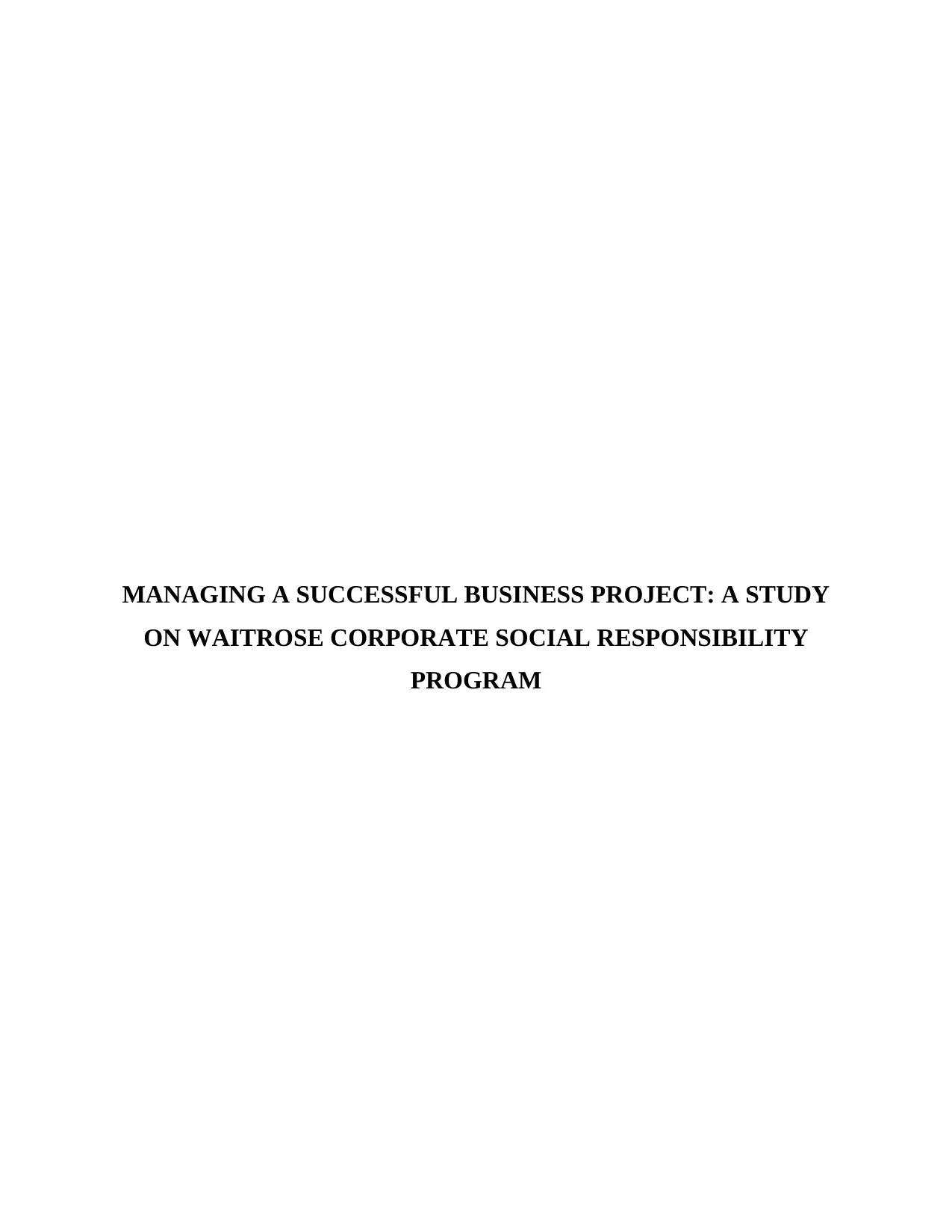
MANAGING A SUCCESSFUL BUSINESS PROJECT: A STUDY
ON WAITROSE CORPORATE SOCIAL RESPONSIBILITY
PROGRAM
ON WAITROSE CORPORATE SOCIAL RESPONSIBILITY
PROGRAM
Paraphrase This Document
Need a fresh take? Get an instant paraphrase of this document with our AI Paraphraser
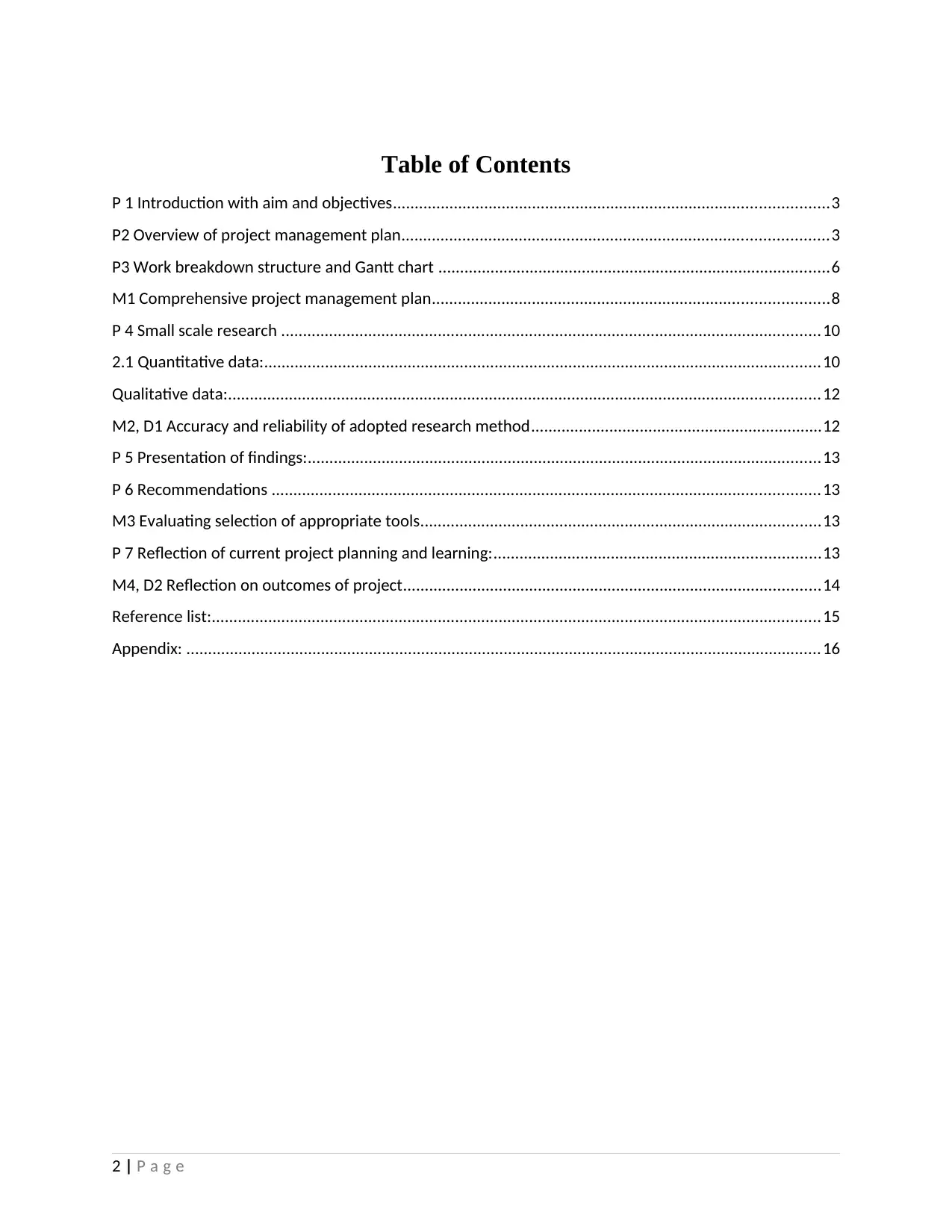
Table of Contents
P 1 Introduction with aim and objectives....................................................................................................3
P2 Overview of project management plan..................................................................................................3
P3 Work breakdown structure and Gantt chart ..........................................................................................6
M1 Comprehensive project management plan...........................................................................................8
P 4 Small scale research ............................................................................................................................10
2.1 Quantitative data:................................................................................................................................10
Qualitative data:........................................................................................................................................12
M2, D1 Accuracy and reliability of adopted research method...................................................................12
P 5 Presentation of findings:......................................................................................................................13
P 6 Recommendations ..............................................................................................................................13
M3 Evaluating selection of appropriate tools............................................................................................13
P 7 Reflection of current project planning and learning:...........................................................................13
M4, D2 Reflection on outcomes of project................................................................................................14
Reference list:............................................................................................................................................15
Appendix: ..................................................................................................................................................16
2 | P a g e
P 1 Introduction with aim and objectives....................................................................................................3
P2 Overview of project management plan..................................................................................................3
P3 Work breakdown structure and Gantt chart ..........................................................................................6
M1 Comprehensive project management plan...........................................................................................8
P 4 Small scale research ............................................................................................................................10
2.1 Quantitative data:................................................................................................................................10
Qualitative data:........................................................................................................................................12
M2, D1 Accuracy and reliability of adopted research method...................................................................12
P 5 Presentation of findings:......................................................................................................................13
P 6 Recommendations ..............................................................................................................................13
M3 Evaluating selection of appropriate tools............................................................................................13
P 7 Reflection of current project planning and learning:...........................................................................13
M4, D2 Reflection on outcomes of project................................................................................................14
Reference list:............................................................................................................................................15
Appendix: ..................................................................................................................................................16
2 | P a g e
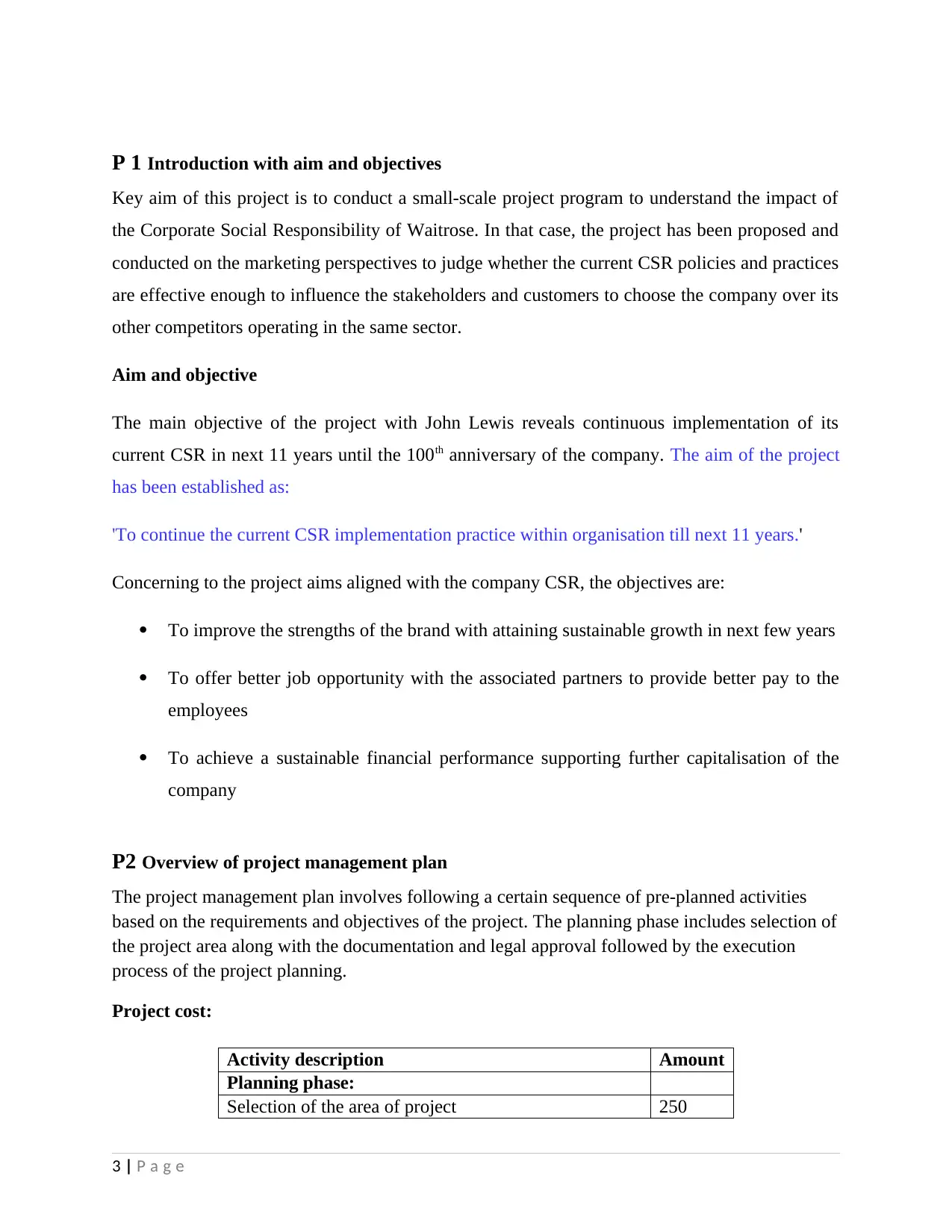
P 1 Introduction with aim and objectives
Key aim of this project is to conduct a small-scale project program to understand the impact of
the Corporate Social Responsibility of Waitrose. In that case, the project has been proposed and
conducted on the marketing perspectives to judge whether the current CSR policies and practices
are effective enough to influence the stakeholders and customers to choose the company over its
other competitors operating in the same sector.
Aim and objective
The main objective of the project with John Lewis reveals continuous implementation of its
current CSR in next 11 years until the 100th anniversary of the company. The aim of the project
has been established as:
'To continue the current CSR implementation practice within organisation till next 11 years.'
Concerning to the project aims aligned with the company CSR, the objectives are:
To improve the strengths of the brand with attaining sustainable growth in next few years
To offer better job opportunity with the associated partners to provide better pay to the
employees
To achieve a sustainable financial performance supporting further capitalisation of the
company
P2 Overview of project management plan
The project management plan involves following a certain sequence of pre-planned activities
based on the requirements and objectives of the project. The planning phase includes selection of
the project area along with the documentation and legal approval followed by the execution
process of the project planning.
Project cost:
Activity description Amount
Planning phase:
Selection of the area of project 250
3 | P a g e
Key aim of this project is to conduct a small-scale project program to understand the impact of
the Corporate Social Responsibility of Waitrose. In that case, the project has been proposed and
conducted on the marketing perspectives to judge whether the current CSR policies and practices
are effective enough to influence the stakeholders and customers to choose the company over its
other competitors operating in the same sector.
Aim and objective
The main objective of the project with John Lewis reveals continuous implementation of its
current CSR in next 11 years until the 100th anniversary of the company. The aim of the project
has been established as:
'To continue the current CSR implementation practice within organisation till next 11 years.'
Concerning to the project aims aligned with the company CSR, the objectives are:
To improve the strengths of the brand with attaining sustainable growth in next few years
To offer better job opportunity with the associated partners to provide better pay to the
employees
To achieve a sustainable financial performance supporting further capitalisation of the
company
P2 Overview of project management plan
The project management plan involves following a certain sequence of pre-planned activities
based on the requirements and objectives of the project. The planning phase includes selection of
the project area along with the documentation and legal approval followed by the execution
process of the project planning.
Project cost:
Activity description Amount
Planning phase:
Selection of the area of project 250
3 | P a g e
⊘ This is a preview!⊘
Do you want full access?
Subscribe today to unlock all pages.

Trusted by 1+ million students worldwide
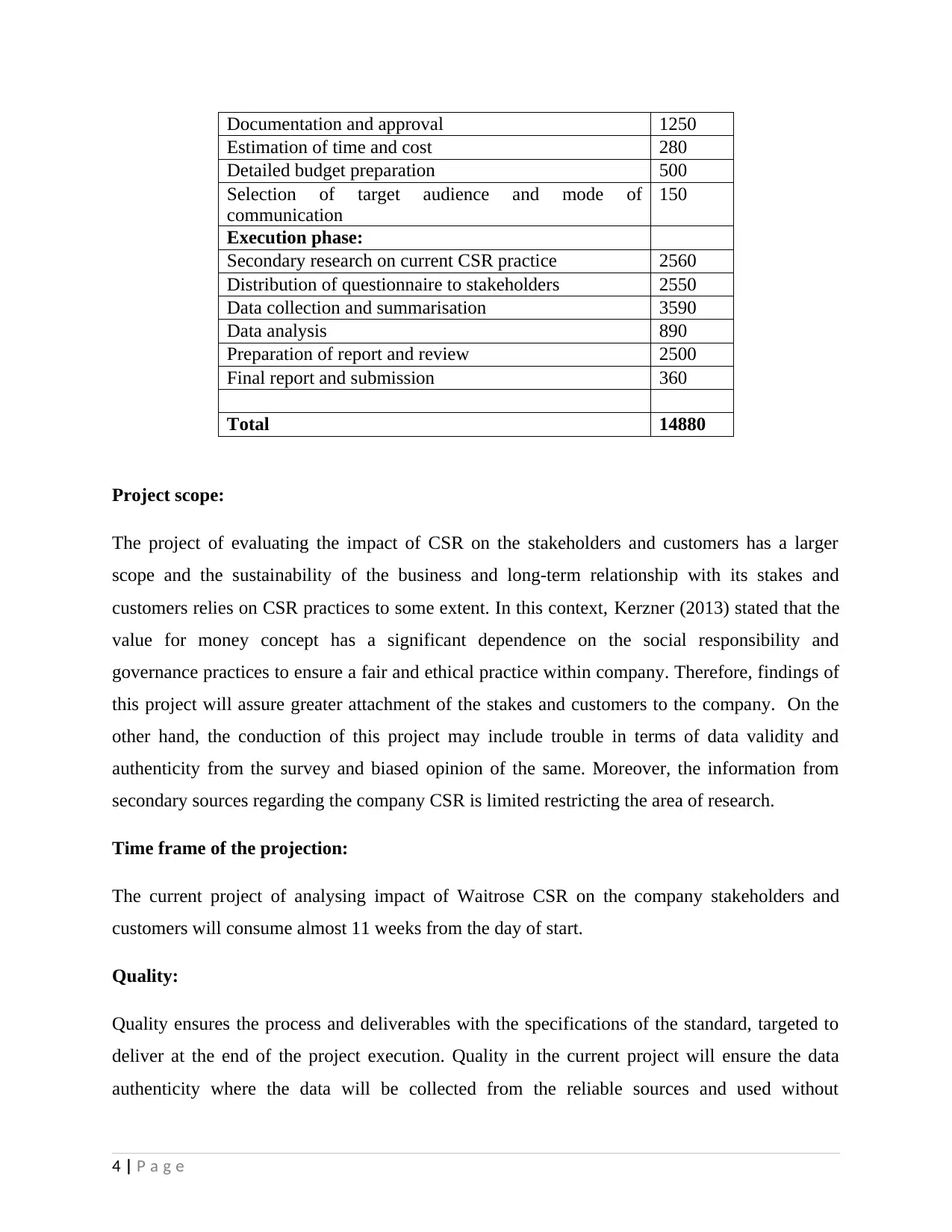
Documentation and approval 1250
Estimation of time and cost 280
Detailed budget preparation 500
Selection of target audience and mode of
communication
150
Execution phase:
Secondary research on current CSR practice 2560
Distribution of questionnaire to stakeholders 2550
Data collection and summarisation 3590
Data analysis 890
Preparation of report and review 2500
Final report and submission 360
Total 14880
Project scope:
The project of evaluating the impact of CSR on the stakeholders and customers has a larger
scope and the sustainability of the business and long-term relationship with its stakes and
customers relies on CSR practices to some extent. In this context, Kerzner (2013) stated that the
value for money concept has a significant dependence on the social responsibility and
governance practices to ensure a fair and ethical practice within company. Therefore, findings of
this project will assure greater attachment of the stakes and customers to the company. On the
other hand, the conduction of this project may include trouble in terms of data validity and
authenticity from the survey and biased opinion of the same. Moreover, the information from
secondary sources regarding the company CSR is limited restricting the area of research.
Time frame of the projection:
The current project of analysing impact of Waitrose CSR on the company stakeholders and
customers will consume almost 11 weeks from the day of start.
Quality:
Quality ensures the process and deliverables with the specifications of the standard, targeted to
deliver at the end of the project execution. Quality in the current project will ensure the data
authenticity where the data will be collected from the reliable sources and used without
4 | P a g e
Estimation of time and cost 280
Detailed budget preparation 500
Selection of target audience and mode of
communication
150
Execution phase:
Secondary research on current CSR practice 2560
Distribution of questionnaire to stakeholders 2550
Data collection and summarisation 3590
Data analysis 890
Preparation of report and review 2500
Final report and submission 360
Total 14880
Project scope:
The project of evaluating the impact of CSR on the stakeholders and customers has a larger
scope and the sustainability of the business and long-term relationship with its stakes and
customers relies on CSR practices to some extent. In this context, Kerzner (2013) stated that the
value for money concept has a significant dependence on the social responsibility and
governance practices to ensure a fair and ethical practice within company. Therefore, findings of
this project will assure greater attachment of the stakes and customers to the company. On the
other hand, the conduction of this project may include trouble in terms of data validity and
authenticity from the survey and biased opinion of the same. Moreover, the information from
secondary sources regarding the company CSR is limited restricting the area of research.
Time frame of the projection:
The current project of analysing impact of Waitrose CSR on the company stakeholders and
customers will consume almost 11 weeks from the day of start.
Quality:
Quality ensures the process and deliverables with the specifications of the standard, targeted to
deliver at the end of the project execution. Quality in the current project will ensure the data
authenticity where the data will be collected from the reliable sources and used without
4 | P a g e
Paraphrase This Document
Need a fresh take? Get an instant paraphrase of this document with our AI Paraphraser
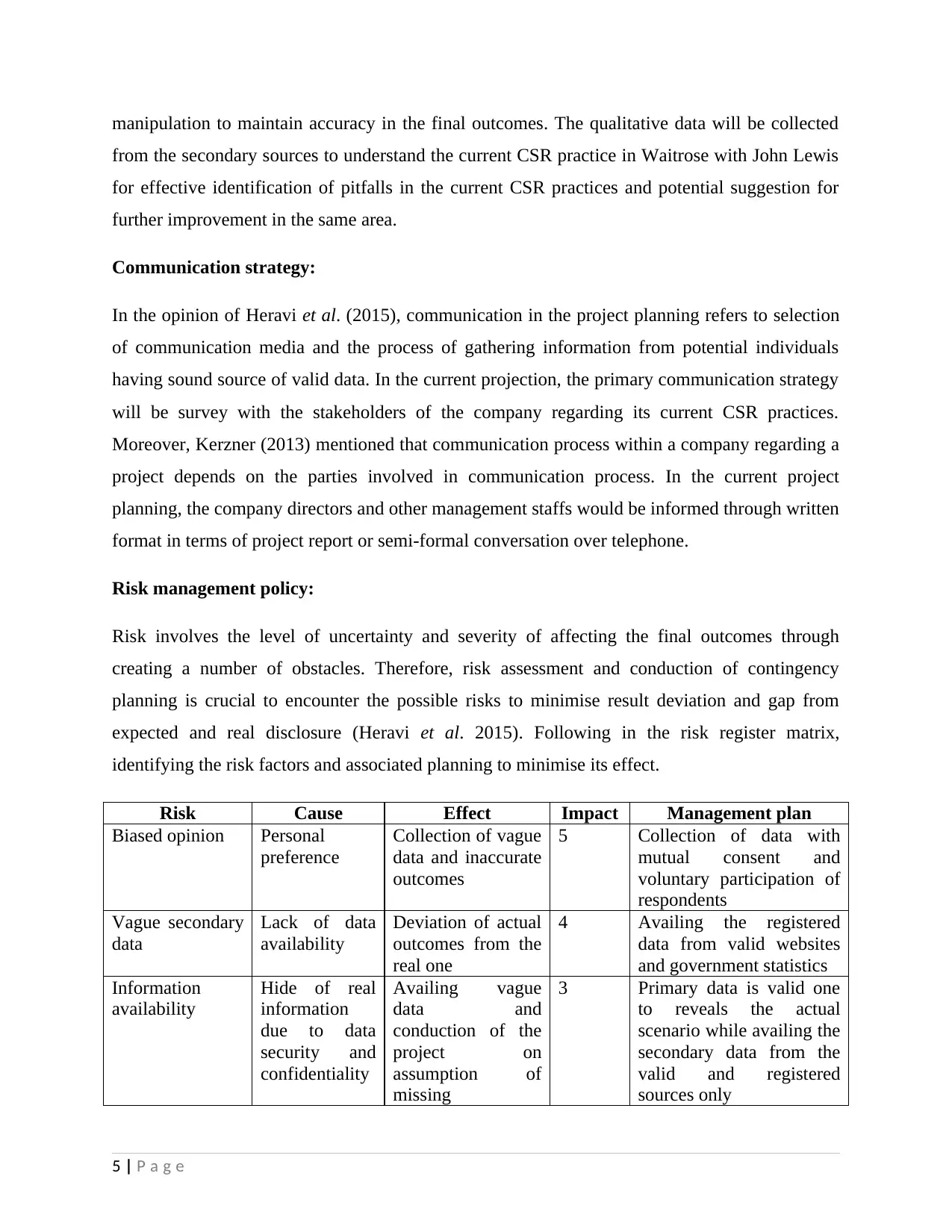
manipulation to maintain accuracy in the final outcomes. The qualitative data will be collected
from the secondary sources to understand the current CSR practice in Waitrose with John Lewis
for effective identification of pitfalls in the current CSR practices and potential suggestion for
further improvement in the same area.
Communication strategy:
In the opinion of Heravi et al. (2015), communication in the project planning refers to selection
of communication media and the process of gathering information from potential individuals
having sound source of valid data. In the current projection, the primary communication strategy
will be survey with the stakeholders of the company regarding its current CSR practices.
Moreover, Kerzner (2013) mentioned that communication process within a company regarding a
project depends on the parties involved in communication process. In the current project
planning, the company directors and other management staffs would be informed through written
format in terms of project report or semi-formal conversation over telephone.
Risk management policy:
Risk involves the level of uncertainty and severity of affecting the final outcomes through
creating a number of obstacles. Therefore, risk assessment and conduction of contingency
planning is crucial to encounter the possible risks to minimise result deviation and gap from
expected and real disclosure (Heravi et al. 2015). Following in the risk register matrix,
identifying the risk factors and associated planning to minimise its effect.
Risk Cause Effect Impact Management plan
Biased opinion Personal
preference
Collection of vague
data and inaccurate
outcomes
5 Collection of data with
mutual consent and
voluntary participation of
respondents
Vague secondary
data
Lack of data
availability
Deviation of actual
outcomes from the
real one
4 Availing the registered
data from valid websites
and government statistics
Information
availability
Hide of real
information
due to data
security and
confidentiality
Availing vague
data and
conduction of the
project on
assumption of
missing
3 Primary data is valid one
to reveals the actual
scenario while availing the
secondary data from the
valid and registered
sources only
5 | P a g e
from the secondary sources to understand the current CSR practice in Waitrose with John Lewis
for effective identification of pitfalls in the current CSR practices and potential suggestion for
further improvement in the same area.
Communication strategy:
In the opinion of Heravi et al. (2015), communication in the project planning refers to selection
of communication media and the process of gathering information from potential individuals
having sound source of valid data. In the current projection, the primary communication strategy
will be survey with the stakeholders of the company regarding its current CSR practices.
Moreover, Kerzner (2013) mentioned that communication process within a company regarding a
project depends on the parties involved in communication process. In the current project
planning, the company directors and other management staffs would be informed through written
format in terms of project report or semi-formal conversation over telephone.
Risk management policy:
Risk involves the level of uncertainty and severity of affecting the final outcomes through
creating a number of obstacles. Therefore, risk assessment and conduction of contingency
planning is crucial to encounter the possible risks to minimise result deviation and gap from
expected and real disclosure (Heravi et al. 2015). Following in the risk register matrix,
identifying the risk factors and associated planning to minimise its effect.
Risk Cause Effect Impact Management plan
Biased opinion Personal
preference
Collection of vague
data and inaccurate
outcomes
5 Collection of data with
mutual consent and
voluntary participation of
respondents
Vague secondary
data
Lack of data
availability
Deviation of actual
outcomes from the
real one
4 Availing the registered
data from valid websites
and government statistics
Information
availability
Hide of real
information
due to data
security and
confidentiality
Availing vague
data and
conduction of the
project on
assumption of
missing
3 Primary data is valid one
to reveals the actual
scenario while availing the
secondary data from the
valid and registered
sources only
5 | P a g e
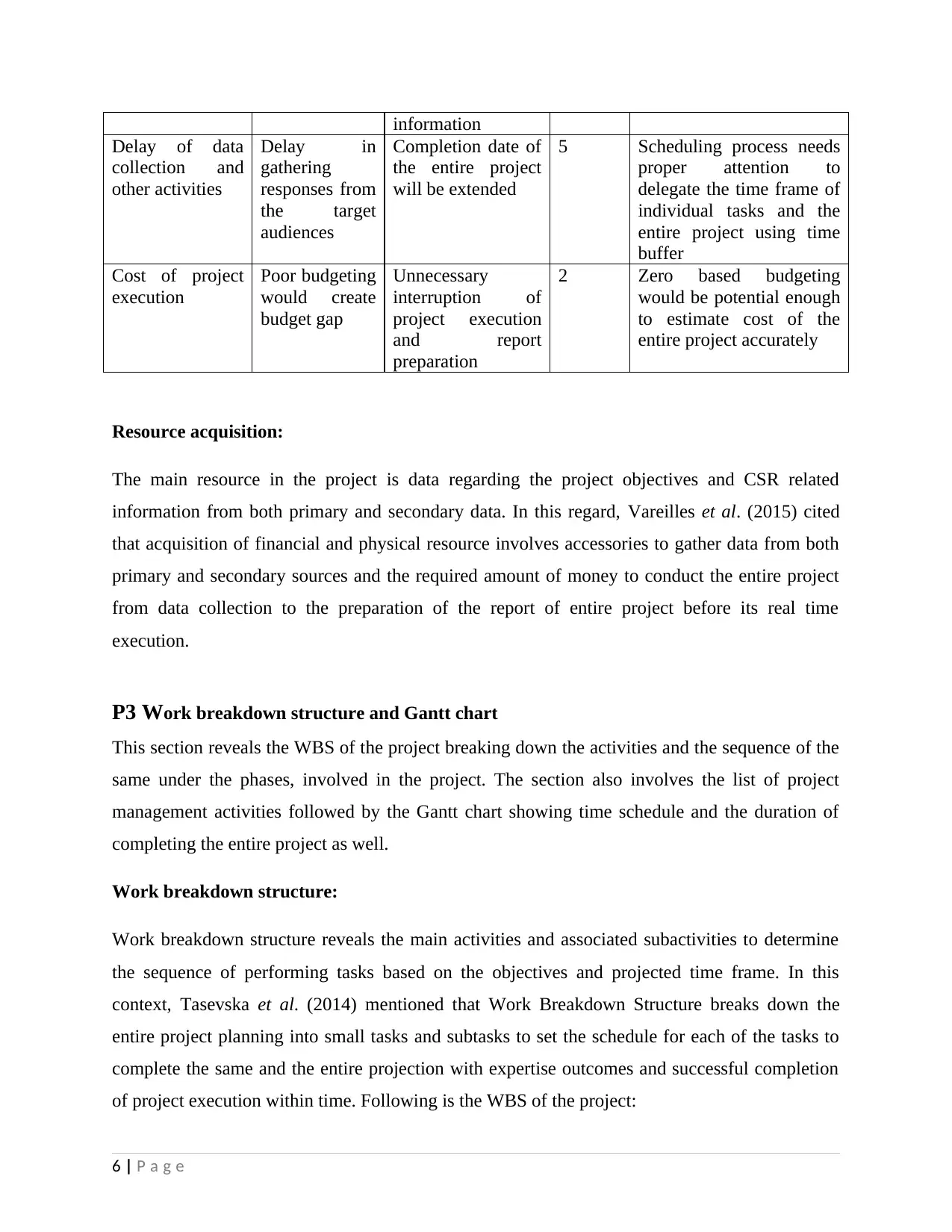
information
Delay of data
collection and
other activities
Delay in
gathering
responses from
the target
audiences
Completion date of
the entire project
will be extended
5 Scheduling process needs
proper attention to
delegate the time frame of
individual tasks and the
entire project using time
buffer
Cost of project
execution
Poor budgeting
would create
budget gap
Unnecessary
interruption of
project execution
and report
preparation
2 Zero based budgeting
would be potential enough
to estimate cost of the
entire project accurately
Resource acquisition:
The main resource in the project is data regarding the project objectives and CSR related
information from both primary and secondary data. In this regard, Vareilles et al. (2015) cited
that acquisition of financial and physical resource involves accessories to gather data from both
primary and secondary sources and the required amount of money to conduct the entire project
from data collection to the preparation of the report of entire project before its real time
execution.
P3 Work breakdown structure and Gantt chart
This section reveals the WBS of the project breaking down the activities and the sequence of the
same under the phases, involved in the project. The section also involves the list of project
management activities followed by the Gantt chart showing time schedule and the duration of
completing the entire project as well.
Work breakdown structure:
Work breakdown structure reveals the main activities and associated subactivities to determine
the sequence of performing tasks based on the objectives and projected time frame. In this
context, Tasevska et al. (2014) mentioned that Work Breakdown Structure breaks down the
entire project planning into small tasks and subtasks to set the schedule for each of the tasks to
complete the same and the entire projection with expertise outcomes and successful completion
of project execution within time. Following is the WBS of the project:
6 | P a g e
Delay of data
collection and
other activities
Delay in
gathering
responses from
the target
audiences
Completion date of
the entire project
will be extended
5 Scheduling process needs
proper attention to
delegate the time frame of
individual tasks and the
entire project using time
buffer
Cost of project
execution
Poor budgeting
would create
budget gap
Unnecessary
interruption of
project execution
and report
preparation
2 Zero based budgeting
would be potential enough
to estimate cost of the
entire project accurately
Resource acquisition:
The main resource in the project is data regarding the project objectives and CSR related
information from both primary and secondary data. In this regard, Vareilles et al. (2015) cited
that acquisition of financial and physical resource involves accessories to gather data from both
primary and secondary sources and the required amount of money to conduct the entire project
from data collection to the preparation of the report of entire project before its real time
execution.
P3 Work breakdown structure and Gantt chart
This section reveals the WBS of the project breaking down the activities and the sequence of the
same under the phases, involved in the project. The section also involves the list of project
management activities followed by the Gantt chart showing time schedule and the duration of
completing the entire project as well.
Work breakdown structure:
Work breakdown structure reveals the main activities and associated subactivities to determine
the sequence of performing tasks based on the objectives and projected time frame. In this
context, Tasevska et al. (2014) mentioned that Work Breakdown Structure breaks down the
entire project planning into small tasks and subtasks to set the schedule for each of the tasks to
complete the same and the entire projection with expertise outcomes and successful completion
of project execution within time. Following is the WBS of the project:
6 | P a g e
⊘ This is a preview!⊘
Do you want full access?
Subscribe today to unlock all pages.

Trusted by 1+ million students worldwide
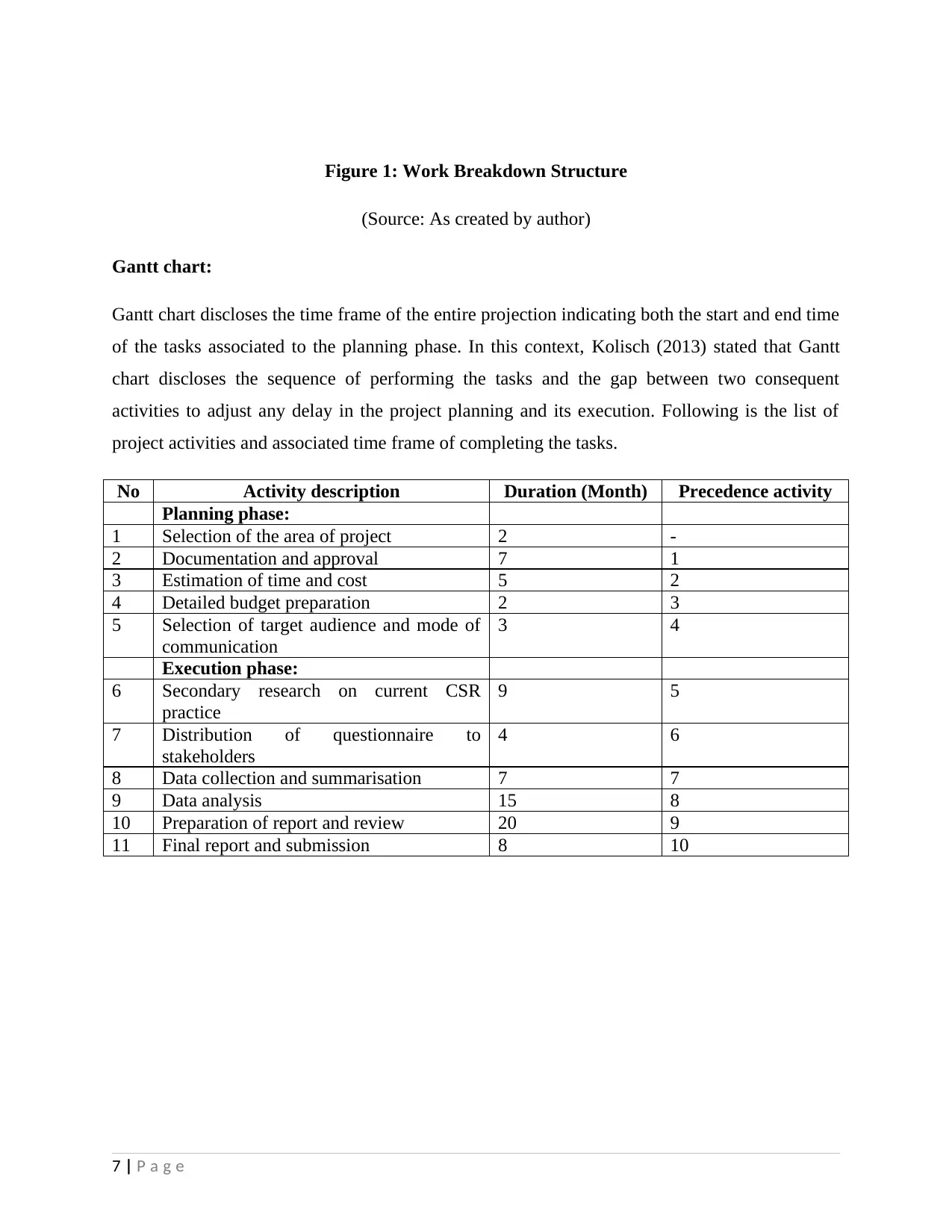
Figure 1: Work Breakdown Structure
(Source: As created by author)
Gantt chart:
Gantt chart discloses the time frame of the entire projection indicating both the start and end time
of the tasks associated to the planning phase. In this context, Kolisch (2013) stated that Gantt
chart discloses the sequence of performing the tasks and the gap between two consequent
activities to adjust any delay in the project planning and its execution. Following is the list of
project activities and associated time frame of completing the tasks.
No Activity description Duration (Month) Precedence activity
Planning phase:
1 Selection of the area of project 2 -
2 Documentation and approval 7 1
3 Estimation of time and cost 5 2
4 Detailed budget preparation 2 3
5 Selection of target audience and mode of
communication
3 4
Execution phase:
6 Secondary research on current CSR
practice
9 5
7 Distribution of questionnaire to
stakeholders
4 6
8 Data collection and summarisation 7 7
9 Data analysis 15 8
10 Preparation of report and review 20 9
11 Final report and submission 8 10
7 | P a g e
(Source: As created by author)
Gantt chart:
Gantt chart discloses the time frame of the entire projection indicating both the start and end time
of the tasks associated to the planning phase. In this context, Kolisch (2013) stated that Gantt
chart discloses the sequence of performing the tasks and the gap between two consequent
activities to adjust any delay in the project planning and its execution. Following is the list of
project activities and associated time frame of completing the tasks.
No Activity description Duration (Month) Precedence activity
Planning phase:
1 Selection of the area of project 2 -
2 Documentation and approval 7 1
3 Estimation of time and cost 5 2
4 Detailed budget preparation 2 3
5 Selection of target audience and mode of
communication
3 4
Execution phase:
6 Secondary research on current CSR
practice
9 5
7 Distribution of questionnaire to
stakeholders
4 6
8 Data collection and summarisation 7 7
9 Data analysis 15 8
10 Preparation of report and review 20 9
11 Final report and submission 8 10
7 | P a g e
Paraphrase This Document
Need a fresh take? Get an instant paraphrase of this document with our AI Paraphraser
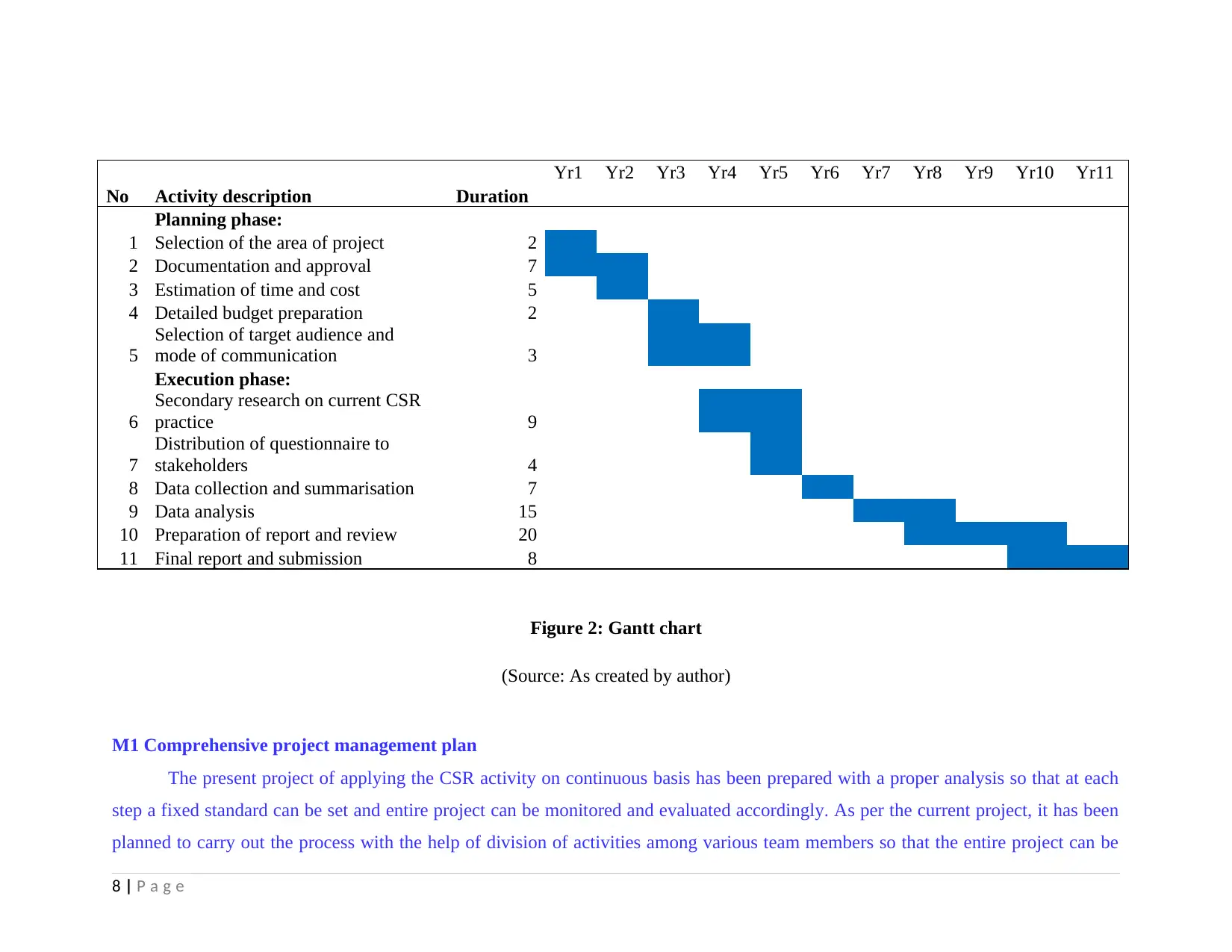
Yr1 Yr2 Yr3 Yr4 Yr5 Yr6 Yr7 Yr8 Yr9 Yr10 Yr11
No Activity description Duration
Planning phase:
1 Selection of the area of project 2
2 Documentation and approval 7
3 Estimation of time and cost 5
4 Detailed budget preparation 2
5
Selection of target audience and
mode of communication 3
Execution phase:
6
Secondary research on current CSR
practice 9
7
Distribution of questionnaire to
stakeholders 4
8 Data collection and summarisation 7
9 Data analysis 15
10 Preparation of report and review 20
11 Final report and submission 8
Figure 2: Gantt chart
(Source: As created by author)
M1 Comprehensive project management plan
The present project of applying the CSR activity on continuous basis has been prepared with a proper analysis so that at each
step a fixed standard can be set and entire project can be monitored and evaluated accordingly. As per the current project, it has been
planned to carry out the process with the help of division of activities among various team members so that the entire project can be
8 | P a g e
No Activity description Duration
Planning phase:
1 Selection of the area of project 2
2 Documentation and approval 7
3 Estimation of time and cost 5
4 Detailed budget preparation 2
5
Selection of target audience and
mode of communication 3
Execution phase:
6
Secondary research on current CSR
practice 9
7
Distribution of questionnaire to
stakeholders 4
8 Data collection and summarisation 7
9 Data analysis 15
10 Preparation of report and review 20
11 Final report and submission 8
Figure 2: Gantt chart
(Source: As created by author)
M1 Comprehensive project management plan
The present project of applying the CSR activity on continuous basis has been prepared with a proper analysis so that at each
step a fixed standard can be set and entire project can be monitored and evaluated accordingly. As per the current project, it has been
planned to carry out the process with the help of division of activities among various team members so that the entire project can be
8 | P a g e

accomplished within time. Here, the project manager will be responsible for monitoring the activities at each stage so that any
deviation in the plans can be corrected at initial stages. Apart from this, the manager will have to make provisions for proper
documentations as we well along with a proper research required for completing the project.
9 | P a g e
deviation in the plans can be corrected at initial stages. Apart from this, the manager will have to make provisions for proper
documentations as we well along with a proper research required for completing the project.
9 | P a g e
⊘ This is a preview!⊘
Do you want full access?
Subscribe today to unlock all pages.

Trusted by 1+ million students worldwide
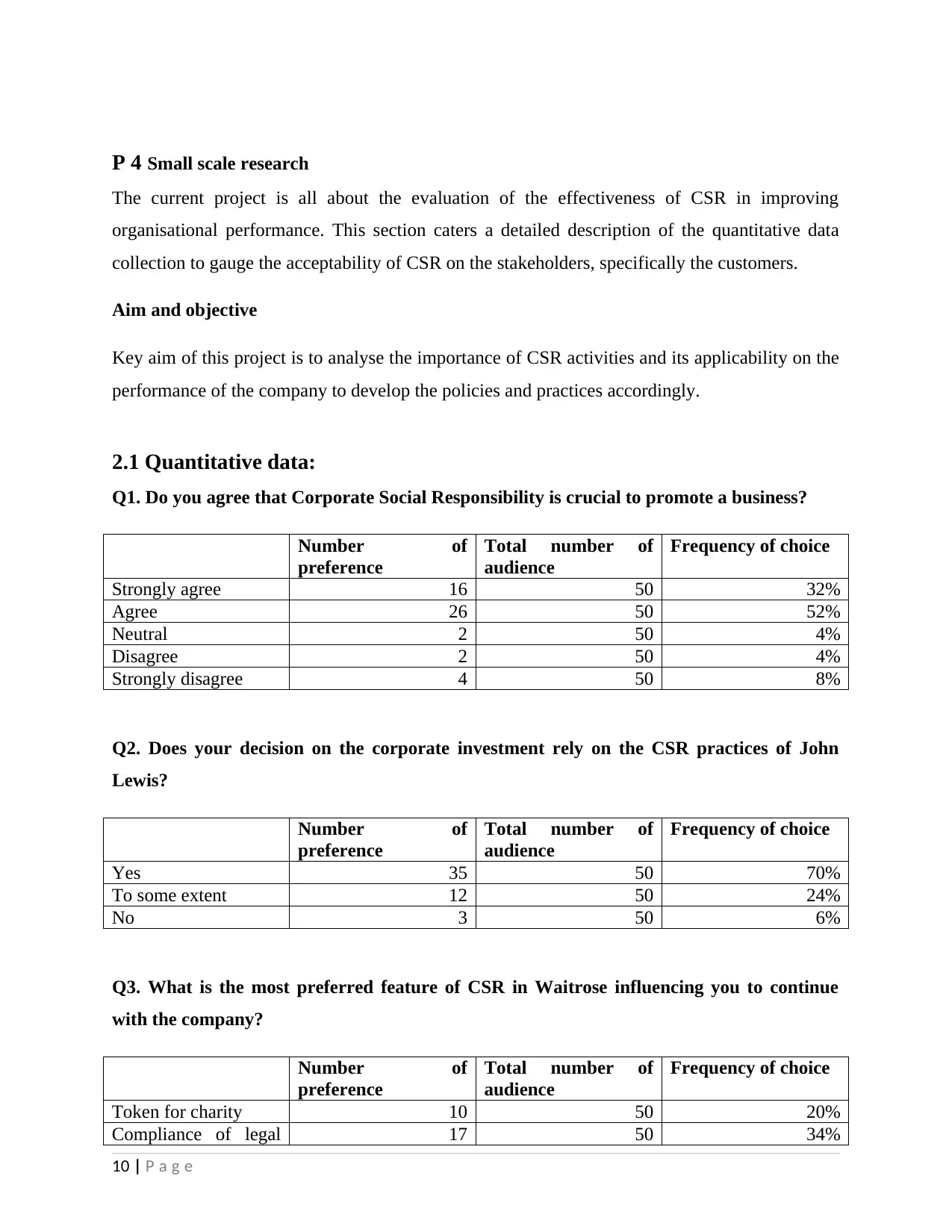
P 4 Small scale research
The current project is all about the evaluation of the effectiveness of CSR in improving
organisational performance. This section caters a detailed description of the quantitative data
collection to gauge the acceptability of CSR on the stakeholders, specifically the customers.
Aim and objective
Key aim of this project is to analyse the importance of CSR activities and its applicability on the
performance of the company to develop the policies and practices accordingly.
2.1 Quantitative data:
Q1. Do you agree that Corporate Social Responsibility is crucial to promote a business?
Number of
preference
Total number of
audience
Frequency of choice
Strongly agree 16 50 32%
Agree 26 50 52%
Neutral 2 50 4%
Disagree 2 50 4%
Strongly disagree 4 50 8%
Q2. Does your decision on the corporate investment rely on the CSR practices of John
Lewis?
Number of
preference
Total number of
audience
Frequency of choice
Yes 35 50 70%
To some extent 12 50 24%
No 3 50 6%
Q3. What is the most preferred feature of CSR in Waitrose influencing you to continue
with the company?
Number of
preference
Total number of
audience
Frequency of choice
Token for charity 10 50 20%
Compliance of legal 17 50 34%
10 | P a g e
The current project is all about the evaluation of the effectiveness of CSR in improving
organisational performance. This section caters a detailed description of the quantitative data
collection to gauge the acceptability of CSR on the stakeholders, specifically the customers.
Aim and objective
Key aim of this project is to analyse the importance of CSR activities and its applicability on the
performance of the company to develop the policies and practices accordingly.
2.1 Quantitative data:
Q1. Do you agree that Corporate Social Responsibility is crucial to promote a business?
Number of
preference
Total number of
audience
Frequency of choice
Strongly agree 16 50 32%
Agree 26 50 52%
Neutral 2 50 4%
Disagree 2 50 4%
Strongly disagree 4 50 8%
Q2. Does your decision on the corporate investment rely on the CSR practices of John
Lewis?
Number of
preference
Total number of
audience
Frequency of choice
Yes 35 50 70%
To some extent 12 50 24%
No 3 50 6%
Q3. What is the most preferred feature of CSR in Waitrose influencing you to continue
with the company?
Number of
preference
Total number of
audience
Frequency of choice
Token for charity 10 50 20%
Compliance of legal 17 50 34%
10 | P a g e
Paraphrase This Document
Need a fresh take? Get an instant paraphrase of this document with our AI Paraphraser
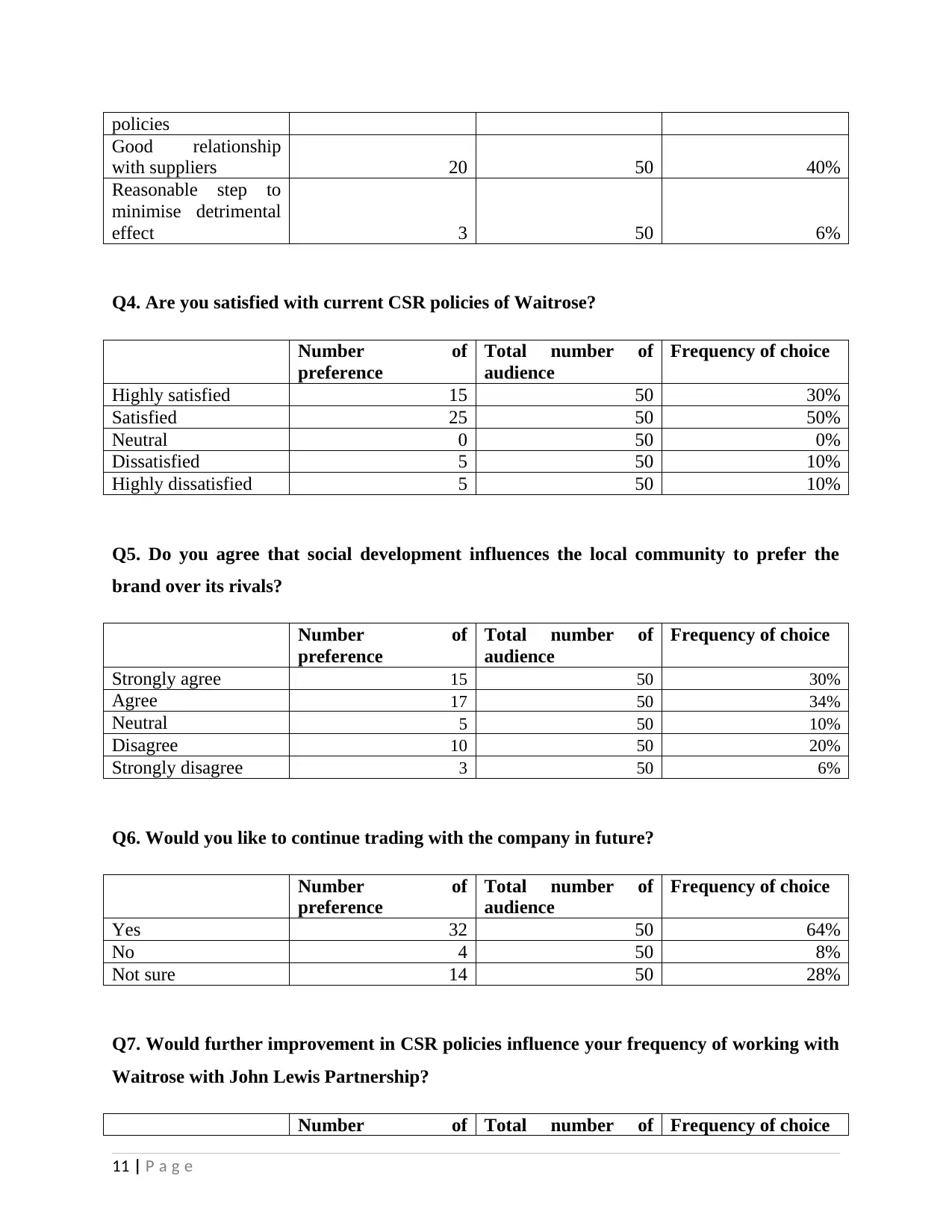
policies
Good relationship
with suppliers 20 50 40%
Reasonable step to
minimise detrimental
effect 3 50 6%
Q4. Are you satisfied with current CSR policies of Waitrose?
Number of
preference
Total number of
audience
Frequency of choice
Highly satisfied 15 50 30%
Satisfied 25 50 50%
Neutral 0 50 0%
Dissatisfied 5 50 10%
Highly dissatisfied 5 50 10%
Q5. Do you agree that social development influences the local community to prefer the
brand over its rivals?
Number of
preference
Total number of
audience
Frequency of choice
Strongly agree 15 50 30%
Agree 17 50 34%
Neutral 5 50 10%
Disagree 10 50 20%
Strongly disagree 3 50 6%
Q6. Would you like to continue trading with the company in future?
Number of
preference
Total number of
audience
Frequency of choice
Yes 32 50 64%
No 4 50 8%
Not sure 14 50 28%
Q7. Would further improvement in CSR policies influence your frequency of working with
Waitrose with John Lewis Partnership?
Number of Total number of Frequency of choice
11 | P a g e
Good relationship
with suppliers 20 50 40%
Reasonable step to
minimise detrimental
effect 3 50 6%
Q4. Are you satisfied with current CSR policies of Waitrose?
Number of
preference
Total number of
audience
Frequency of choice
Highly satisfied 15 50 30%
Satisfied 25 50 50%
Neutral 0 50 0%
Dissatisfied 5 50 10%
Highly dissatisfied 5 50 10%
Q5. Do you agree that social development influences the local community to prefer the
brand over its rivals?
Number of
preference
Total number of
audience
Frequency of choice
Strongly agree 15 50 30%
Agree 17 50 34%
Neutral 5 50 10%
Disagree 10 50 20%
Strongly disagree 3 50 6%
Q6. Would you like to continue trading with the company in future?
Number of
preference
Total number of
audience
Frequency of choice
Yes 32 50 64%
No 4 50 8%
Not sure 14 50 28%
Q7. Would further improvement in CSR policies influence your frequency of working with
Waitrose with John Lewis Partnership?
Number of Total number of Frequency of choice
11 | P a g e
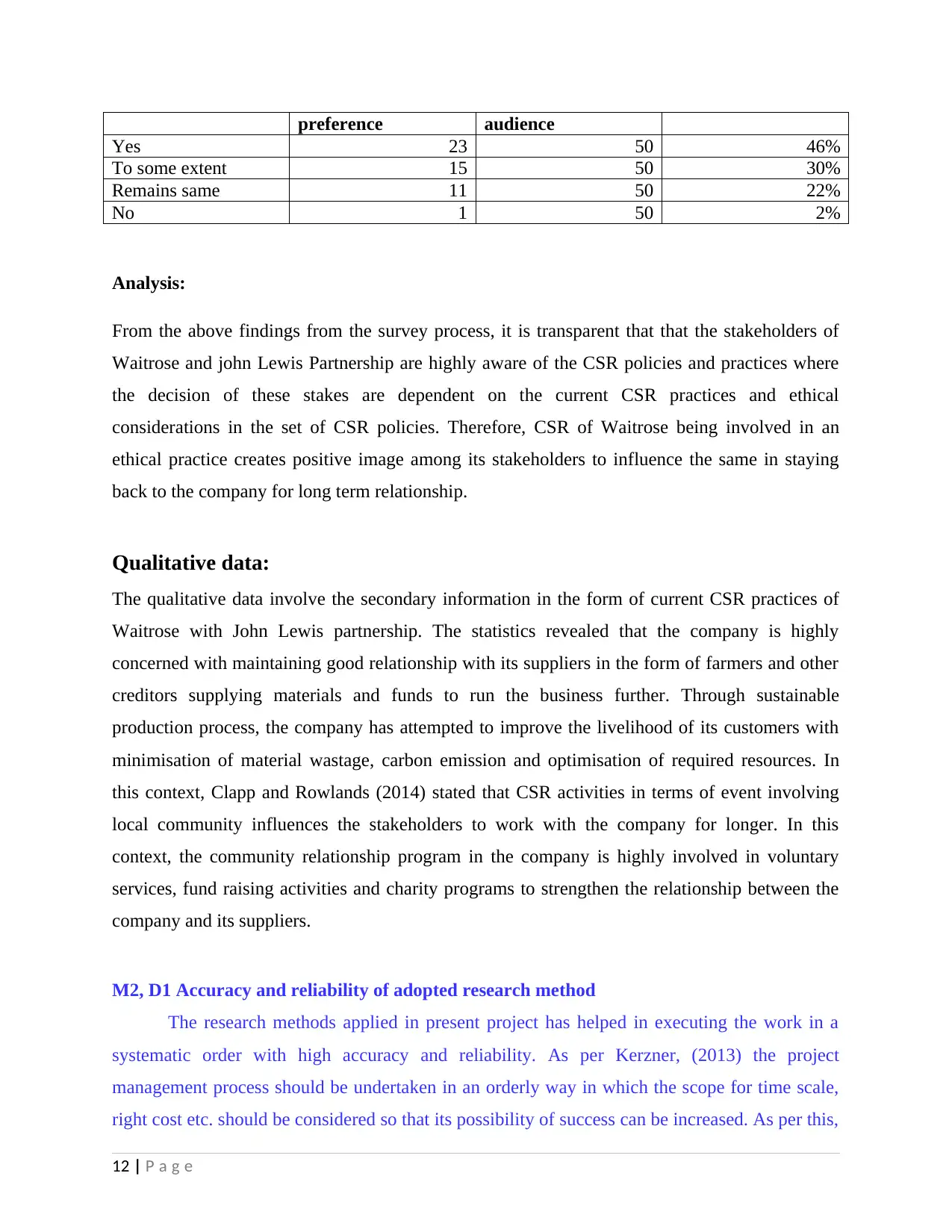
preference audience
Yes 23 50 46%
To some extent 15 50 30%
Remains same 11 50 22%
No 1 50 2%
Analysis:
From the above findings from the survey process, it is transparent that that the stakeholders of
Waitrose and john Lewis Partnership are highly aware of the CSR policies and practices where
the decision of these stakes are dependent on the current CSR practices and ethical
considerations in the set of CSR policies. Therefore, CSR of Waitrose being involved in an
ethical practice creates positive image among its stakeholders to influence the same in staying
back to the company for long term relationship.
Qualitative data:
The qualitative data involve the secondary information in the form of current CSR practices of
Waitrose with John Lewis partnership. The statistics revealed that the company is highly
concerned with maintaining good relationship with its suppliers in the form of farmers and other
creditors supplying materials and funds to run the business further. Through sustainable
production process, the company has attempted to improve the livelihood of its customers with
minimisation of material wastage, carbon emission and optimisation of required resources. In
this context, Clapp and Rowlands (2014) stated that CSR activities in terms of event involving
local community influences the stakeholders to work with the company for longer. In this
context, the community relationship program in the company is highly involved in voluntary
services, fund raising activities and charity programs to strengthen the relationship between the
company and its suppliers.
M2, D1 Accuracy and reliability of adopted research method
The research methods applied in present project has helped in executing the work in a
systematic order with high accuracy and reliability. As per Kerzner, (2013) the project
management process should be undertaken in an orderly way in which the scope for time scale,
right cost etc. should be considered so that its possibility of success can be increased. As per this,
12 | P a g e
Yes 23 50 46%
To some extent 15 50 30%
Remains same 11 50 22%
No 1 50 2%
Analysis:
From the above findings from the survey process, it is transparent that that the stakeholders of
Waitrose and john Lewis Partnership are highly aware of the CSR policies and practices where
the decision of these stakes are dependent on the current CSR practices and ethical
considerations in the set of CSR policies. Therefore, CSR of Waitrose being involved in an
ethical practice creates positive image among its stakeholders to influence the same in staying
back to the company for long term relationship.
Qualitative data:
The qualitative data involve the secondary information in the form of current CSR practices of
Waitrose with John Lewis partnership. The statistics revealed that the company is highly
concerned with maintaining good relationship with its suppliers in the form of farmers and other
creditors supplying materials and funds to run the business further. Through sustainable
production process, the company has attempted to improve the livelihood of its customers with
minimisation of material wastage, carbon emission and optimisation of required resources. In
this context, Clapp and Rowlands (2014) stated that CSR activities in terms of event involving
local community influences the stakeholders to work with the company for longer. In this
context, the community relationship program in the company is highly involved in voluntary
services, fund raising activities and charity programs to strengthen the relationship between the
company and its suppliers.
M2, D1 Accuracy and reliability of adopted research method
The research methods applied in present project has helped in executing the work in a
systematic order with high accuracy and reliability. As per Kerzner, (2013) the project
management process should be undertaken in an orderly way in which the scope for time scale,
right cost etc. should be considered so that its possibility of success can be increased. As per this,
12 | P a g e
⊘ This is a preview!⊘
Do you want full access?
Subscribe today to unlock all pages.

Trusted by 1+ million students worldwide
1 out of 17
Related Documents
Your All-in-One AI-Powered Toolkit for Academic Success.
+13062052269
info@desklib.com
Available 24*7 on WhatsApp / Email
![[object Object]](/_next/static/media/star-bottom.7253800d.svg)
Unlock your academic potential
Copyright © 2020–2025 A2Z Services. All Rights Reserved. Developed and managed by ZUCOL.





